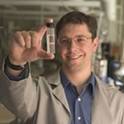The feasibility of removing small organic acids from the aqueous fraction of fast pyrolysis bio-oils using nanofiltration (NF) and reverse osmosis (RO) membranes was studied. Experiments were conducted with commercially available polymeric NF and RO membranes and aqueous solutions of increasing complexity, i.e., single solute solutions of acetic acid and glucose, binary solute solutions containing both acetic acid and glucose, and a model aqueous fraction of bio-oil (AFBO) containing acetic acid, formic acid, hydroxyacetone, furfural, guaiacol, catechol and glucose. Feed concentrations close to those in real AFBO were chosen. These concentrations, ranging as high as 34 wt%, were generally at least an order of magnitude higher than previously studied in the literature for related membrane separations. Retention factors above 90% for glucose and below 0% for acetic acid were observed at feed pressures near 40 bar for single and binary solutions, so that their separation in the model AFBO was expected to be feasible. However, all of the membranes were irreversibly damaged when experiments were conducted with the model AFBO due to the presence of guaiacol in the feed solution. Experiments with model AFBO excluding guaiacol were also conducted. NF membranes showed retention factors of glucose greater than 80% and of acetic acid less than −15% when operated at transmembrane pressures near 60 bar
Available at: http://works.bepress.com/george_huber/12/
